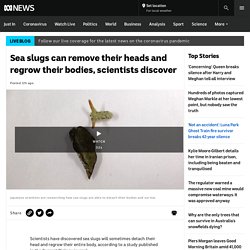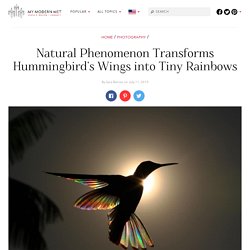

Sea slugs can remove their heads and regrow their bodies, scientists discover. Scientists have discovered sea slugs will sometimes detach their head and regrow their entire body, according to a study published in the Current Biology journal.

The sea slugs were observed removing their own bodiesIt is suspected they use photosynthesis to survive while their organs are regrowingScientists hope the discovery can aid research into growing human tissue While we know of many instances of this process, called "autotomy", such as when lizards regrow their tails, this latest discovery has been hailed by researchers as one of the most extreme cases known to science. Biology researcher Sayaka Mitoh, who specialises in Japanese sea slugs, one day entered the lab to find one of the creatures had decapitated itself and the head kept on moving and living. Then a couple more followed suit. Ms Mitoh then teamed up with Yoichi Yusa, an aquatic ecology professor at Japan's Nara Women's University aquatic ecology, to try to recreate the phenomenon.
Seed-sized chameleon found in Madagascar may be world's tiniest reptile. Scientists say they have discovered a sunflower-seed-sized subspecies of chameleon that may well be the smallest reptile on Earth.

Two of the miniature lizards, one male and one female, were discovered by a German-Madagascan expedition team in northern Madagascar. The male Brookesia nana, or nano-chameleon, has a body that is only 13.5mm (0.53 inches) long, making it the smallest of all the roughly 11,500 known species of reptiles, the Bavarian State Collection of Zoology in Munich said. Its total length from nose to tail is just under 22mm (0.87 inch). The female nano-chameleon is significantly larger, with an overall length of 29mm, the research institute said, adding that the scientists were unable to find further specimens of the new subspecies “despite great effort”. The species’ closest relative is the slightly larger Brookesia micra, whose discovery was announced in 2012. The Find-a-spider Guide - Find-a-spider. Birding. Amazing spider baffles scientists with huge web.
Spider Net Building Timelapse. Hundreds of dead whales spur on efforts to save the few remaining survivors - ABC News. Why do whales strand themselves and why is it so common in Tasmania? - ABC News. Lyrebird may join threatened species, as scale of bird habitat lost to bushfires emerges. The superb lyrebird, famous for its ability to mimic almost any sound, may have plunged from being a common to a threatened species after its three varieties lost between a third and more than half of their known habitat in the bushfire crisis.

A preliminary analysis by Birdlife Australia found that both the central and northern superb lyrebirds, located in NSW and southern Queensland, were likely to have had more than 50% of their habitat affected by fire. The southern superb lyrebird, from Victoria and southern NSW, is estimated to have had 34% of where it lives burned. Across the country, the group found 19 birds had more than half their habitat seriously affected by fire. Another 58 had lost over a third of the area they live in. Sixteen of the most severely affected are endemic to tiny Kangaroo Island, the South Australian territory that scientists say appears the most devastated wildlife area. Bright feathers, bright brains: hummingbirds 'can order numerically'
Hummingbirds are not only bright in appearance but also in brain, it would seem, with new research suggesting the tiny creatures are able to understand a numerical concept of order.

While hummingbirds have previously been found to visit flowers in particular sequences when foraging, researchers say the new study suggests this process could be based on the concept of “first”, “second” and so on, rather than features such as specific flower location or nearby landmarks. However, it does not mean that hummingbirds can count. “Counting has a more anthropocentric connotation,” said Dr Maria Tello-Ramos of the University of St Andrews, a co-author of the study. “This is more like ordering things in a sequence. We cannot say [the hummingbirds] were counting, ‘One, two, three, four,’ but that they knew that [the] fourth [flower] was different from the third flower that they encountered,” she said. Amazing Shots of a Rainbow Hummingbird Captures Natural Phenonmena. Artist and photographer Christian Spencer was standing on his verandah in Rio de Janeiro when he made an amazing discovery.

When the black Jacobin hummingbird flew with the sun striking its open wings, a beautiful prism effect appeared. At that moment, it was as if its body was made of rainbows. In 2011, Spencer recorded the bird's movements for a film called The Dance of Time. The movie went on to receive 10 international awards as well as three best film honors. But, that wasn’t the end of the rainbow hummingbirds. Although Winged Prism seems too magical to be true, Spencer says that there wasn't any digital manipulation involved. One image from Winged Prism is now available as a limited edition print from Spencer’s website.
Artist and photographer Christian Spencer captured the awe-inspiring sight of the sun shining on a black Jacobin hummingbird's wings. The result is a prism effect and makes it look as though the creature's body is made of rainbows. Related Articles: